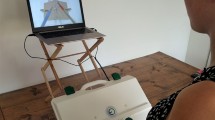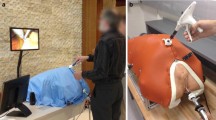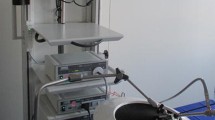Abstract
Purpose
Surgical simulation modules for “open” surgery are limited in contrast to well-studied and validated laparoscopic trainers. In this study, face, content and construct validity of a devised simulation module (Berlin Operation Trainer, BOPT) for handsewn anastomoses in digestive surgery were analysed.
Materials and methods
Participants of a skills course for digestive surgery (novices: 1–3 years of training; experts: more than 5 years of training) were timed on performing four defined handsewn digestive anastomoses on formalin fixed porcine intestine in the BOPT. Questionnaires were answered regarding impression with the simulation module concerning appearance and realism using a five-point Likert and a three-point forced choice scale. Face and content validities were evaluated based on the responses of participants and construct validity by comparing novices to experts. Data collected were analysed with Fisher’s exact test and two-sample t test.
Results
Twenty-two novices (median: second postgraduate year) and 26 experts (median: seventh postgraduate year) were enrolled in the study. The BOPT showed strong face and content validities with average scores for satisfaction parameters above 4.2 ± 0.41 and 4.1 ± 0.22, respectively. Construct validity was adequate for anastomosis simulation in the BOPT based on different percentages of anastomosis complete during set time between novices and experts as shown for simple (68.2% vs. 92.3%, p = 0.038) and for difficult anastomosis (18.2% vs. 50.0%, p = 0.021).
Conclusions
The BOPT is a suitable instrument for advanced surgical training for novices and experienced colleagues creating a realistic and demanding situation. Further studies have to evaluate if a more realistic preoperative training will support an effective transfer of learned techniques to the operating room.





Similar content being viewed by others
References
Semm K (1986) Pelvi-trainer, a training device in operative pelviscopy for teaching endoscopic ligation and suture technics. Geburtshilfe Frauenheilkd 46(1):60–62
Gallagher AG et al (2003) Psychomotor skills assessment in practicing surgeons experienced in performing advanced laparoscopic procedures. J Am Coll Surg 197(3):479–488
Grantcharov TP et al (2004) Randomized clinical trial of virtual reality simulation for laparoscopic skills training. Br J Surg 91(2):146–150
Lehmann KS et al (2005) A prospective randomized study to test the transfer of basic psychomotor skills from virtual reality to physical reality in a comparable training setting. Ann Surg 241(3):442–449
Vick LR et al (2007) Face, content, and construct validities of inanimate intestinal anastomoses simulation. J Surg Educ 64(6):365–368
McDougall EM et al (2006) Construct validity testing of a laparoscopic surgical simulator. J Am Coll Surg 202(5):779–787
Zhang A et al (2008) Construct validity testing of a laparoscopic surgery simulator (Lap Mentor): evaluation of surgical skill with a virtual laparoscopic training simulator. Surg Endosc 22(6):1440–1444
Brewin J, Nedas T, Challacombe B et al. (2010) Face, content and construct validation of the first virtual reality laparoscopic nephrectomy simulator. BJU Int (in press)
Kenney PA et al (2009) Face, content, and construct validity of dV-trainer, a novel virtual reality simulator for robotic surgery. Urology 73(6):1288–1292
Schijven M, Jakimowicz J (2003) Construct validity: experts and novices performing on the Xitact LS500 laparoscopy simulator. Surg Endosc 17(5):803–810
Schijven M, Jakimowicz J (2002) Face-, expert, and referent validity of the Xitact LS500 laparoscopy simulator. Surg Endosc 16(12):1764–1770
Karras DJ (1997) Statistical methodology: II. Reliability and validity assessment in study design, Part B. Acad Emerg Med 4(2):144–147
Marshall RL et al (2000) Practical training for postgraduate year 1 surgery residents. Am J Surg 179(3):194–196
MacFadyen BV Jr (2004) Teaching, training, and clinical surgery: are we making a difference? Surg Endosc 18(3):361–362
Babineau TJ et al (2004) The “cost” of operative training for surgical residents. Arch Surg 139(4):366–369, discussion 369–370
Bridges M, Diamond DL (1999) The financial impact of teaching surgical residents in the operating room. Am J Surg 177(1):28–32
Vanderveen K, Chen M, Scherer L (2007) Effects of resident duty-hours restrictions on surgical and nonsurgical teaching faculty. Arch Surg 142(8):759–764, discussion 764–766
Hutter MM et al (2006) The impact of the 80-hour resident workweek on surgical residents and attending surgeons. Ann Surg 243(6):864–871, discussion 871–875
Waurick R et al (2007) The European Working Time Directive: effect on education and clinical care. Curr Opin Anaesthesiol 20(6):576–579
Taflampas P, Christodoulakis M, Tsiftsis DD (2009) Anastomotic leakage after low anterior resection for rectal cancer: facts, obscurity, and fiction. Surg Today 39(3):183–188
Hamilton EC et al (2002) Comparison of video trainer and virtual reality training systems on acquisition of laparoscopic skills. Surg Endosc 16(3):406–411
Torkington J et al (2001) Skill transfer from virtual reality to a real laparoscopic task. Surg Endosc 15(10):1076–1079
Hyltander A et al (2002) The transfer of basic skills learned in a laparoscopic simulator to the operating room. Surg Endosc 16(9):1324–1328
Ahlberg G et al (2002) Does training in a virtual reality simulator improve surgical performance? Surg Endosc 16(1):126–129
Acknowledgements
We would like to thank Mr. Breuer and Mr. Lehmann, technical assistants at the CFM of Charité–Universitätsmedizin Berlin and Mr. Dipl.-Ing. Lubisch (Polywerk, Berlin, Germany) for the technical implementation and realisation of the plans. We would also like to thank the persons who participated in the validation of the BOPT. The Berlin Operation Trainer (BOPT) is a protected utility patent of Charité University Medicine Berlin, Germany (CH313/2006).
Authors’ contributions
All authors contributed to the study conception and design. J Gröne and J.C. Lauscher were assigned with the acquisition of data. Analysis and interpretation of data was done by all authors. J Gröne took care of the drafting of the manuscript. All authors contributed to the critical revision of the manuscript.
Author information
Authors and Affiliations
Corresponding author
Rights and permissions
About this article
Cite this article
Gröne, J., Lauscher, J.C., Buhr, H.J. et al. Face, content and construct validity of a new realistic trainer for conventional techniques in digestive surgery. Langenbecks Arch Surg 395, 581–588 (2010). https://doi.org/10.1007/s00423-010-0641-2
Received:
Accepted:
Published:
Issue Date:
DOI: https://doi.org/10.1007/s00423-010-0641-2




